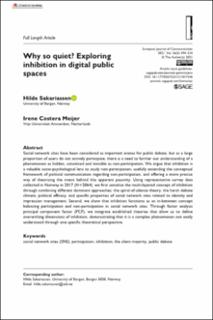Why so quiet? Exploring inhibition in digital public spaces
Journal article, Peer reviewed
Published version

Åpne
Permanent lenke
https://hdl.handle.net/11250/2838571Utgivelsesdato
2021Metadata
Vis full innførselSamlinger
Originalversjon
Central European Journal of Communication. 2021, 36 (5), 494-510 10.1177/02673231211017346Sammendrag
Social network sites have been considered as important arenas for public debate, but as a large proportion of users do not actively participate, there is a need to further our understanding of a phenomenon as hidden, unnoticed and invisible as non-participation. We argue that inhibition is a valuable socio-psychological lens to study non-participation, usefully extending the conceptual framework of political communication regarding non-participation, and offering a more precise way of theorising the intent behind this apparent passivity. Using representative survey data collected in Norway in 2017 (N = 2064), we first sensitise the multi-layered concept of inhibition through combining different dominant approaches: the spiral-of-silence theory, the harsh debate climate, political efficacy, and specific properties of social network sites related to identity and impression management. Second, we show that inhibition functions as an in-between concept balancing participation and non-participation in social network sites. Through factor analysis principal component factor (PCF), we integrate established theories that allow us to define overarching dimensions of inhibition, demonstrating that it is a complex phenomenon not easily understood through one specific theoretical perspective.
